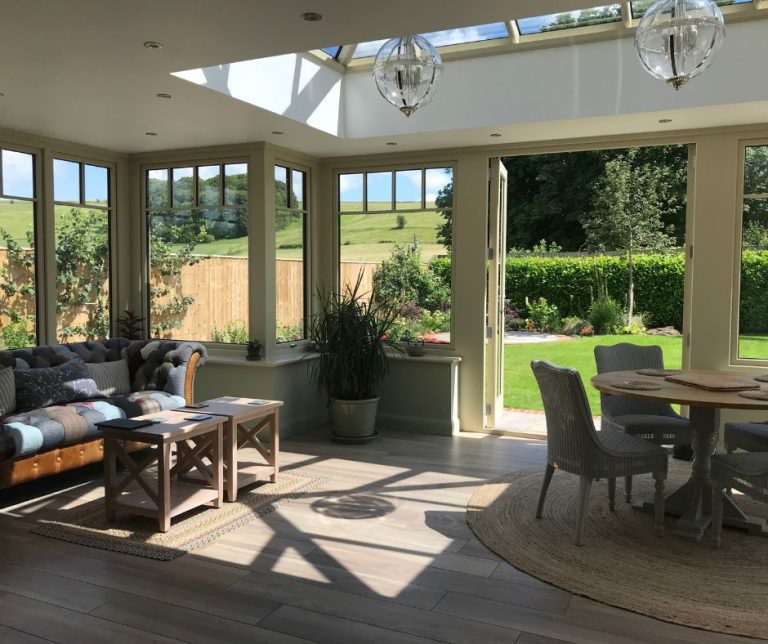Choosing Your Orangery Roof: Glass, Polycarbonate, or Solid?
The roof of your orangery is more than just a cover; it’s a critical component that dictates natural light, thermal performance, and the overall feel of the space. When considering an orangery, or even an orangery roof replacement, understanding the differences between glass, polycarbonate, and solid options is key to making the right investment for your home. At Farrow & Jones, we pride ourselves on guiding our clients through these essential decisions, ensuring their orangery is perfectly suited to their lifestyle and needs.
What are the Pros and Cons of a Glass Orangery Roof?
A glass orangery roof is a popular choice, renowned for its aesthetic appeal and the abundance of natural light it provides.
Pros:
- Maximum Light Transmission: Glass roofs allow the most natural light to flood into your orangery, creating an incredibly bright and airy space that feels seamlessly connected to the outdoors. This is particularly enhanced by the integrated Roof Lanterns that are a hallmark of orangery design.
- Clear Views: Enjoy unobstructed views of the sky and stars, perfect for a relaxing evening or a bright daytime retreat.
- Aesthetics: A glass roof often offers a sleek, modern, and sophisticated appearance, complementing contemporary and classic homes alike.
- Durability and Longevity: Modern glass is incredibly durable and resistant to scratching and discolouration, offering a long lifespan with proper maintenance.
Cons:
- Heat Gain/Loss: Without high-performance glazing, glass can be less thermally efficient, leading to excessive heat gain in summer and heat loss in winter. However, this is largely mitigated by advanced solar control and low-emissivity (Low-E) glass, which we specify in our designs.
- Noise: Rain hitting a glass roof can be louder than on a solid or polycarbonate roof, though specialist acoustic glass can reduce this.
- Glare: Direct sunlight can sometimes cause glare, though this can be managed with blinds or advanced glass coatings.
When is a Solid Orangery Roof the Best Choice?
The solid orangery roof has gained immense popularity for those seeking a more integrated extension feel, akin to a traditional room.
Pros:
- Superior Thermal Efficiency: Solid roofs, typically constructed with highly insulated panels and often incorporating a plastered ceiling internally, offer excellent thermal performance. This makes your orangery feel more like a conventional room, easier to heat in winter and cooler in summer.
- Reduced Glare and Noise: The opaque nature of a solid roof eliminates glare from direct sunlight and significantly reduces noise from rain or hail, creating a more tranquil environment.
- Enhanced Integration: A solid roof allows for seamless integration of lighting, speakers, and other electrical points into the ceiling, offering more design flexibility.
- More “Room-Like” Feel: For those desiring a less exposed and more robust extension, a solid roof delivers the feeling of a permanent, conventional living space.
Cons:
- Less Natural Light: The primary drawback is the reduction in overhead natural light compared to a glass roof. This is why a solid orangery roof invariably features a large glazed roof lantern to allow light to penetrate the centre of the space.
- Less Direct View of Sky: Views of the sky are limited to the roof lantern opening.
If you’re considering a more traditional room-like extension, explore our Orangeries to see how solid roofs are integrated.

How Does Your Roof Choice Impact Orangery Use?
The choice between a glass, polycarbonate, or solid roof fundamentally influences how you’ll use and enjoy your orangery throughout the year.
- Year-Round Comfort: For truly year-round orangery use, thermal performance is paramount. A high-specification glass orangery roof with modern coatings, or an insulated solid orangery roof, will ensure comfortable temperatures regardless of the season, extending the usability of your space. While polycarbonate roofs are generally a more budget-friendly option, offering some insulation, they typically don’t match the thermal performance or longevity of high-grade glass or solid options. The polycarbonate roof benefits often revolve around cost-effectiveness and good light diffusion, but for a premium orangery, they are less common.
- Acoustics and Ambiance: A solid roof provides a quieter, more enclosed feel, ideal for a study, library, or a formal dining area. A glass roof, while brighter, might be livelier with more ambient noise, perfect for a breakfast nook or casual lounge.
- Interior Design Freedom: A solid roof offers more scope for ceiling lighting and decorative elements, allowing you to create a sophisticated interior. Glass roofs rely more on natural light, dictating a design that embraces its transparency.
At Farrow & Jones, we work closely with you to understand your vision, ensuring your chosen roof type perfectly complements your bespoke orangery. Whether it’s for an orangery roof replacement or a brand new build, our expertise guarantees a durable, beautiful, and thermally efficient solution. Discover more about our approach to quality and design by visiting our Technical Specifications page or exploring our range of Bespoke Conservatories and Orangeries.
Get in Touch Today
If you are ready to start creating your new orangery, extension or conservatory simply get in touch by filling out this contact form. Alternatively, you can call us on 01926 810 291 for a no-obligation discussion.
To learn more about the steps that go into our builds and to see the recent projects and designs we have worked on, then check out our gallery here.
Lastly, to keep up with all of our news and to find some inspiration, you can follow us on Instagram and Facebook.
